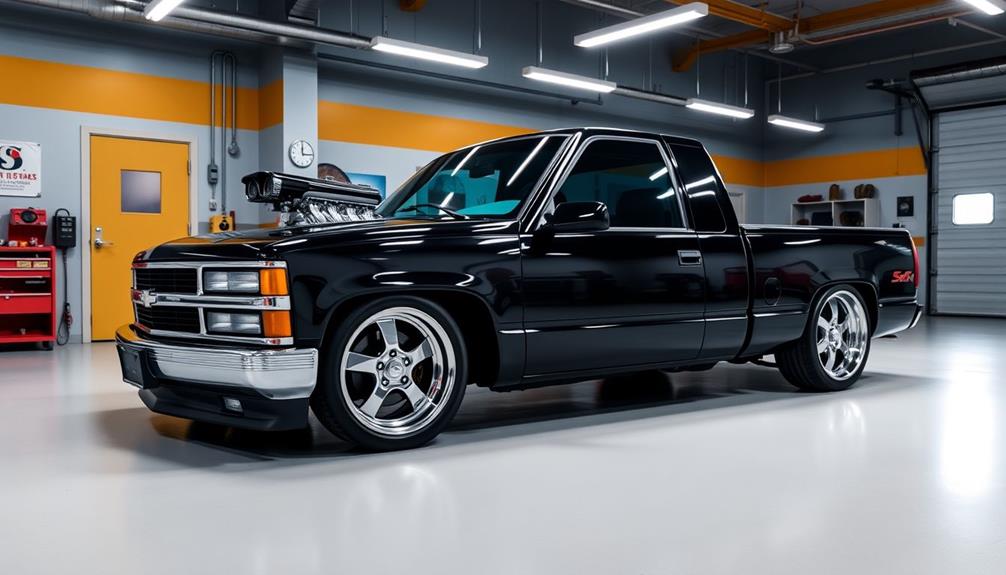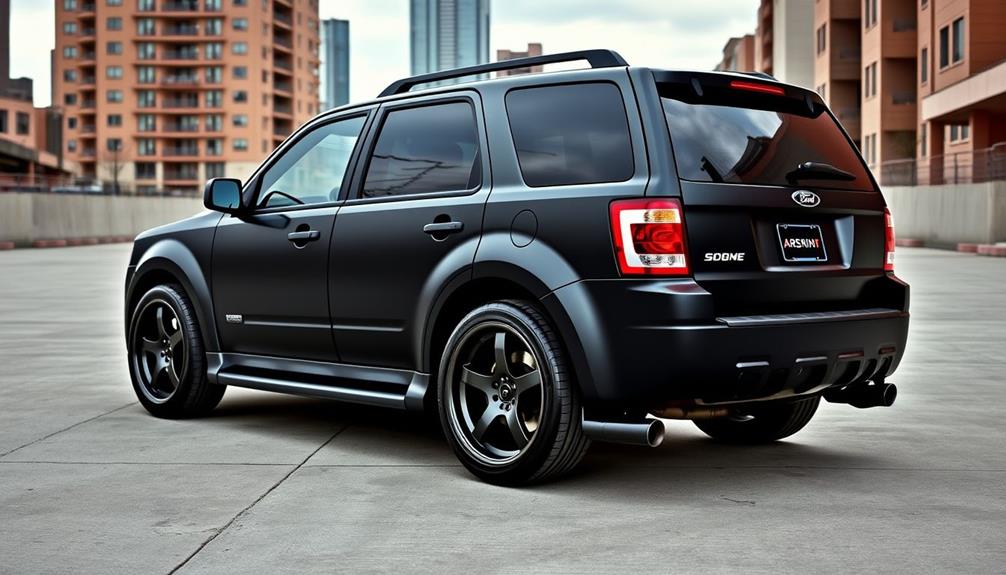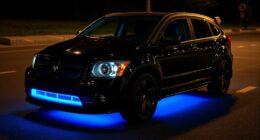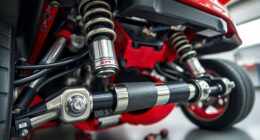Tuning your '99 Ford Ranger can greatly boost its power and performance. Start by using tools like the X-cal 2 Tuner for efficient engine adjustments. Don't overlook the speed limiter; fine-tuning it improves throttle response and allows for custom speed settings. Focus on modifying fuel tables and ignition timing to maximize efficiency. Regular maintenance, like changing spark plugs and air filters, keeps your engine healthy. Consider performance upgrades like a full 3-inch exhaust and aftermarket air filters for added horsepower. There's plenty more you can do to transform your dependable truck into a powerhouse.
Key Takeaways
- Utilize the SCT X-cal 2 Tuner for efficient tuning and improved engine performance adjustments.
- Fine-tune fuel tables and ignition timing to enhance combustion efficiency and power delivery.
- Adjust the speed limiter and rev limits for better throttle response and top speed potential.
- Regular maintenance, including spark plug and filter replacements, ensures optimal engine performance.
- Consider aftermarket upgrades like high-flow exhaust systems and improved air filters for added horsepower.
Tuning Recommendations and Tools
When tuning your 1999 Ford Ranger, it's essential to choose the right tools and recommendations to maximize performance. Start with the X-cal 2 tuner; it's highly recommended for its efficiency and reliability, avoiding the communication issues often seen with alternatives like Bama and Henson. This tool provides great value for performance tuning, guaranteeing you get the most out of your ride.
For further tuning recommendations, consider Lasota Racing. They're known for responsive customer service and extensive knowledge of SCT products, making them a dependable choice for Ranger owners.
If you're looking to explore deeper, the Pro Racer Software offers varied tuning capabilities at consumer, tuner, and SCT levels. Keep in mind, though, that it doesn't access ABS and Restraints parameters in the PCM.
As you tune, remember to pay close attention to engine and transmission parameters. Ongoing adjustments are necessary for peak performance and efficiency, especially if you've made modifications to your vehicle.
Speed Limiter Adjustments

When tuning your 1999 Ford Ranger, adjusting the speed limiter can greatly enhance your vehicle's performance.
By raising or lowering the limit, you can improve throttle response and achieve smoother drivability.
Understanding how the speed limiter functions will help you make informed decisions for ideal tuning results.
Speed Limiter Functionality
Adjusting the speed limiter on your 1999 Ford Ranger can greatly enhance your driving experience. The factory setting typically caps your speed between 65 mph and 120 mph, depending on the calibration of your Powertrain Control Module (PCM).
By adjusting this speed limiter, you can enjoy smoother shifts at higher speeds and improved throttle response.
Here are some key points to reflect upon when working with your speed limiter:
- Incremental Adjustments: Make small changes to the speed limiter settings to maintain safety.
- Fuel Cut-Off: Unlike newer models, your Ranger cuts fuel to all injectors at once, so adjustments matter.
- Performance Gains: Disabling or adjusting the speed limiter can improve overall performance, but be cautious.
- Safety First: High speeds can lead to safety issues; always drive responsibly.
- Calibration Strategy: Understand your PCM's calibration strategy to optimize your adjustments.
Performance Gains Explained
By fine-tuning the speed limiter on your 1999 Ford Ranger, you can access significant performance gains that enhance your driving experience. Adjusting the speed limiter allows for higher speeds and smoother power delivery, improving your vehicle's overall responsiveness. Proper calibration can enhance throttle response and shift firmness, making your driving more engaging.
Here's a quick overview of the potential performance gains from speed limiter adjustments:
| Adjustment Type | Performance Gains |
|---|---|
| Incremental Increase | Improved throttle response |
| Complete Disable | Maximum speed potential |
| Calibration Optimization | Smoother power shifts |
| Range Adjustment | Tailored driving experience |
| Safety Consideration | Maintained engine reliability |
While older models typically cut fuel to injectors for speed control, you can avoid risking engine damage by making incremental adjustments. Disabling the speed limiter entirely can free your Ranger's full potential, but always weigh safety against performance gains. By carefully calibrating your speed limiter, you can enjoy an enhanced driving experience without compromising reliability.
Engine and Transmission Tuning
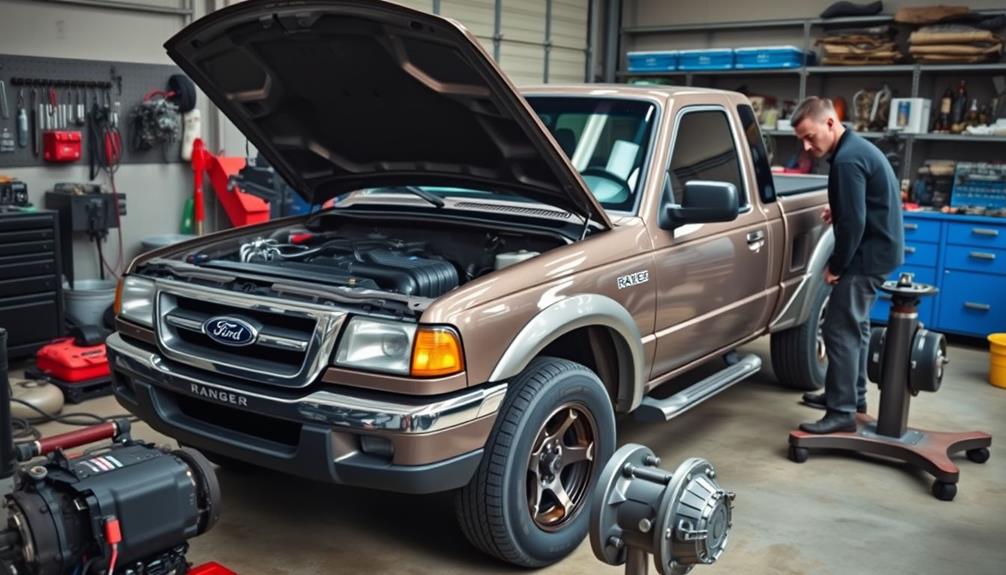
Tuning the engine and transmission of your 1999 Ford Ranger can considerably enhance its performance, making every drive more enjoyable.
By focusing on engine and transmission tuning, you can release more horsepower and torque while ensuring your truck runs safely within fuel limits.
Here are some key steps to contemplate:
- Adjust the fuel tables and ignition timing for ideal performance.
- Modify transmission parameters like lowering shift points for improved drivability.
- Use the SCT X-cal 2 tuner to access and customize your engine and transmission settings.
- Implement a wideband air/fuel meter to achieve the best air-fuel ratios, maximizing combustion efficiency.
- Regularly monitor the Keep Alive Memory (KAM) in the PCM to maintain accurate fuel and timing adjustments.
Speed and Rev Limiting
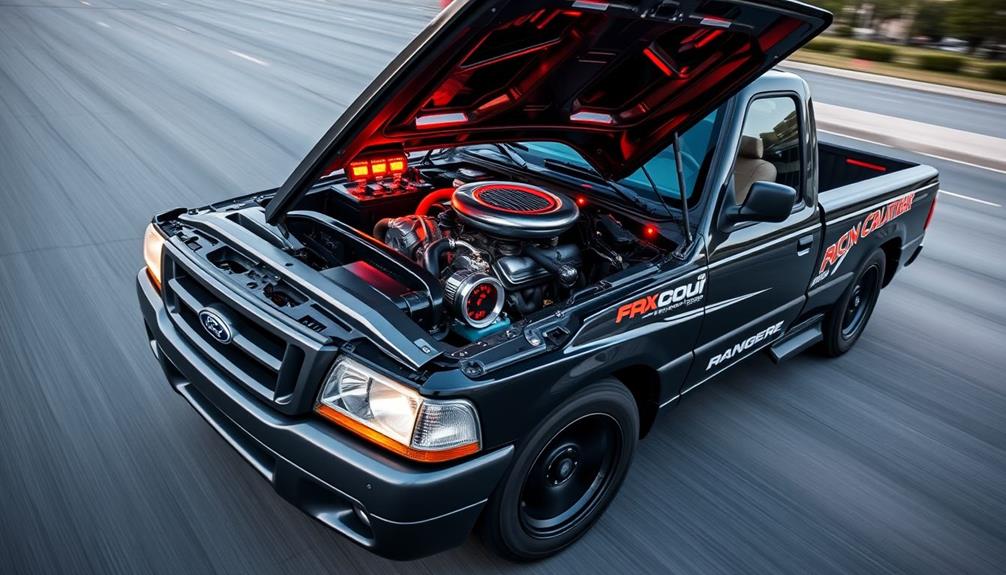
After optimizing your engine and transmission, it's time to focus on speed and rev limiting to further enhance your 1999 Ford Ranger's performance. One key element is the speed limiter, which can be adjusted or even turned off, allowing you to achieve higher top speeds than the factory settings permit. Imagine the thrill of pushing your Ranger to its limits!
Additionally, customizing rev limits can improve drivability. Many drivers find the factory setting of 5000 RPM in neutral excessive for everyday use. Lowering shift points during transmission tuning can lead to firmer shifts and quicker throttle response. Adjusting the torque converter lock-up point can also enhance acceleration and provide a smoother ride.
Here's a quick comparison of potential adjustments:
| Adjustment Type | Factory Setting | Custom Setting |
|---|---|---|
| Speed Limiter | 100 mph | Off |
| Rev Limit (Neutral) | 5000 RPM | 4000 RPM |
| Shift Points | Stock | Lowered |
| Torque Converter Lock-up | Standard | Optimized |
| Overall Responsiveness | Average | Excellent |
With properly calibrated speed and rev limits, you'll enjoy smoother changes and a more responsive engine, transforming your driving experience.
PCM Learning Process

When tuning your Ford Ranger, you'll need to start with the PCM learning process, which begins with an initial flash that requires disconnecting the battery.
It's essential to follow specific steps, like using the headlights on/off method, to reset the module effectively.
Once you've completed the flash, give the engine some idle time to adjust the air-fuel ratios for peak performance.
Initial Flash Steps
To begin the initial PCM flash process for your 1999 Ford Ranger, you'll first need to disconnect the battery. Start by removing the negative battery cable. This step is essential to guarantee a clean slate for your tuning modifications.
Once that's done, follow these steps to expedite the reset process:
- Turn on the headlights for about 30 seconds.
- Turn them off and then back on again.
- Wait for a few moments before reconnecting the negative battery cable.
- Start your engine and let it idle for a sufficient time.
- Monitor the air-fuel ratios to verify the system is adapting correctly.
After the tuning is complete, the PCM will need time to adjust its air-fuel mixtures. During this learning process, it shifts from stoichiometric to rich and lean mixtures, with a smooth idle indicating successful adjustments.
Make sure you utilize a wideband A/F meter and datalogging tools to track changes accurately. This attention to detail helps guarantee that your Ranger performs at its best, fully benefiting from the modifications you've made.
Idle Adjustment Importance
Proper idle adjustment is essential for your Ford Ranger's performance, especially during the PCM learning process. After an initial flash, you'll need to disconnect the battery to reset the system, which sets the stage for accurate idle adjustments.
Once you've tuned your engine, it's critical to allow idle time for the PCM to recalibrate the air-fuel ratios. This shift from stoichiometric to rich and lean mixtures is fundamental for achieving peak performance.
A successful PCM learning process will be evident through a smooth idle, indicating that the PCM has adapted to the new tuning parameters. Remember, your idle adjustment can greatly impact your vehicle's drivability. As the PCM learns, it fine-tunes fuel delivery and ignition timing based on current driving conditions.
Regular monitoring of idle behavior after tuning is important. This guarantees that the PCM continues to perform efficiently, allowing your Ranger to operate smoothly.
Pay attention to any irregularities in idle, as they could signal that further adjustments are necessary. Keeping your idle adjusted not only enhances performance but also prolongs the life of your engine, giving you the reliability you expect from your Ford Ranger.
Basic Tune-Up Components
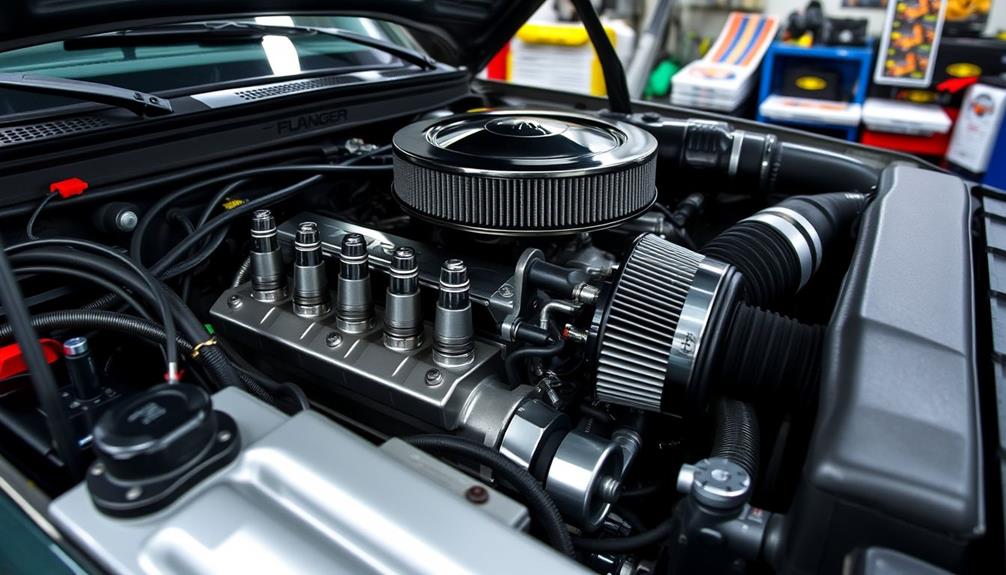
What essential components do you need for a basic tune-up of your 1999 Ford Ranger?
Keeping your engine running smoothly requires a few key parts that help maintain performance and reliability. Regular maintenance guarantees your catalytic converter works efficiently and prevents costly repairs down the line.
Here's what you'll need:
- Spark Plugs: Replace every 20,000-30,000 miles with Ford/Motorcraft parts, avoiding Champion plugs.
- Fuel Filter: Change this to guarantee your engine gets clean fuel.
- Air Filter: A clean air filter helps improve airflow, enhancing engine performance.
- PCV Valve: This helps regulate engine pressure and prevent oil leaks.
- Oil and Oil Filter: Regular changes keep your engine lubricated and healthy.
When you're changing spark plugs, remember to use compressed air to clear debris from the wells, preventing contamination.
Install new plugs with anti-seize compound and guarantee they're properly gapped, tightening them to specified torque values.
Performance Upgrade Options

Upgrading your 1999 Ford Ranger can transform its performance, making every drive more enjoyable. One effective way to start is by replacing the factory airbox with an aftermarket airbox or pod filter. This modification can yield an increase in power of up to 5 horsepower by improving airflow and engine responsiveness.
Additionally, swapping out the factory intercooler for an aluminum version can boost performance by approximately 9 kW at the wheels, thanks to better cooling capabilities.
For those looking to enhance handling, installing aftermarket coilovers, like Bilstein, can greatly improve suspension performance. This upgrade works best when combined with camber correction for lifts over 3 inches.
Don't overlook the exhaust system; a full 3-inch exhaust upgrade with a high-flow catalytic converter alleviates restrictions, leading to improved horsepower and overall engine performance.
Finally, consider EGR blanking modifications, which could offer a potential increase in power and torque of up to 30% without altering the factory tune.
Common Issues and Solutions

Even with performance upgrades, your 1999 Ford Ranger can still face common issues that require attention.
Addressing these problems promptly can keep your vehicle running smoothly and maximize its potential.
Here are some common issues you might encounter:
- Engine knocking: This may indicate low oil levels or worn components. Check your oil regularly to avoid serious damage.
- High RPM readings: A malfunctioning throttle position sensor (TPS) can cause this. Inspect and replace it if necessary for peak engine function.
- Stalling or poor acceleration: Often due to a clogged fuel filter or dirty air filter. Replace these regularly to maintain performance.
- Electrical problems: Flickering lights or battery issues often stem from corroded connections. Clean or replace affected components to resolve these.
- Ignition issues: Hard starting or misfiring can usually be fixed by replacing worn spark plugs and ensuring proper ignition timing.
Frequently Asked Questions
How Can I Make My 4.0 Ford Ranger Faster?
To make your 4.0 faster, upgrade the air intake and exhaust systems, tune the PCM for peak performance, and consider nitrous injection. Regular maintenance, like spark plug changes, keeps your engine running smoothly and efficiently.
How to Make a 2.3 L Ranger Faster?
To make your 2.3L Ranger faster, upgrade the air intake and exhaust systems, tune the engine, and add a performance chip. These modifications enhance airflow, optimize performance, and boost horsepower, giving your ride a noticeable kick.
How Much HP Can a Ford Ranger Make?
You wouldn't believe how much horsepower a Ford Ranger can release! Depending on modifications, it can reach over 250 hp. With the right upgrades and tuning, your Ranger could become a true powerhouse on the road.
What Are Common Problems With 1999 Ford Rangers?
You might encounter several common problems with a 1999 Ford Ranger, including engine knocking, stalling, poor acceleration, and electrical issues. Ignition and fuel delivery problems often contribute to overall performance and reliability concerns.
Conclusion
In the quest to maximize your '99 Ford Ranger's power, think of it as tuning a classic guitar—every adjustment harmonizes performance. By exploring tuning recommendations, upgrading components, and addressing common issues, you'll release the beast beneath the hood. Like a skilled musician, you'll find that each tweak brings you closer to the perfect melody of speed and reliability. So, roll up your sleeves and transform your trusty pickup into a symphony of power that's music to your ears!

